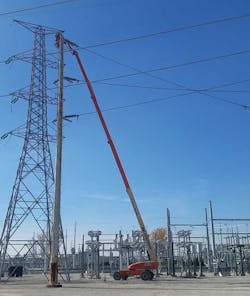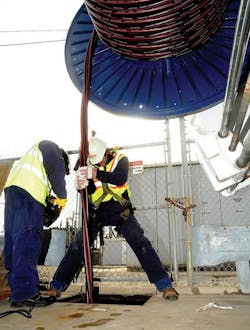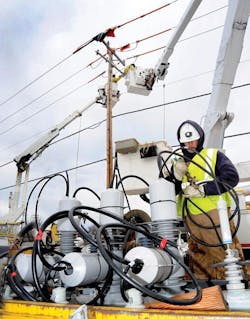ComEd Builds the Utility of the Future
The growing integration of distributed energy resources in distribution networks, all-time-high expectations of electricity customers for the low-cost and reliable supply of electricity, and an increasing number of extreme weather events — all combined with an aging transmission and distribution network, built mainly in the late 1960s and 1970s — have made the case for necessary investments in upgrading the current electricity infrastructure and undertaking innovative approaches.
Commonwealth Edison (ComEd) — a unit of Exelon Corp. (Chicago, Illinois, U.S.) that provides service to approximately 3.8 million customers across northern Illinois, or 70% of the state’s population — is well on its way to addressing some of these pressing concerns while paving the way for advancement of the grid by leveraging smart grid physical and communications infrastructure. ComEd’s efforts in modernization of the electric grid are made possible by the Energy Infrastructure Modernization Act (EIMA), which not only provides the people of Illinois with better service and greater control over their electricity usage, but also will help to prepare the state to meet the growing energy demands of the 21st century economy.
Energy Infrastructure Modernization Act
On Oct. 27, 2011, the Illinois General Assembly enacted EIMA, setting in motion a US$2.6 billion investment by ComEd to strengthen and modernize the state’s northern electric grid. The objective of EIMA is to improve system performance through accelerated investment in programs that address aging distribution infrastructure and storm hardening while expanding the use of smart grid technology. The total investment is equally divided into two efforts: capital electric infrastructure upgrades and capital smart grid system upgrades.
The portion of EIMA slated for capital electric infrastructure upgrades is $1.3 billion and covers a variety of high-impact programs:
• An underground residential distribution (URD) cable upgrade with Okonite to proactively address issues with URD cable systems through replacement or fluid injection
• A mainline underground system, which represents one of the most complex reliability-related investments and includes the assessment and refurbishment of manholes, along with the replacement of mainline underground cable (primarily in urban areas)
• A 69-kV underground cable system upgrade to replace high-voltage cables
• The upgrade of wood poles, which includes the inspection, treatment and replacement of approximately 50% of ComEd’s 1.5 million poles
• Storm hardening, which is aimed to reduce the susceptibility of circuits to storm-related damage, including, but not limited to, overhead-to-underground conversion, the installation of tree-resistant conductors and enhanced vegetation management
• The construction of two new state-of-the-art training facilities.
The other $1.3 billion of EIMA represents a range of timely smart grid capital system upgrades:
• Distribution automation (DA), through investments in sectionalizing devices from G&W Electric and S&C Electric, and remote communications to detect issues on the distribution system and automatically reroute power to minimize the number of customers impacted.
• Ten intelligent substations that employ advanced fault detection, remote asset monitoring and improved site security
• Advanced metering infrastructure (AMI), which includes the installation of more than 4 million smart meters by 2018
• A cyber-secure data communications network from Silver Spring Networks.
EIMA further provides an innovative performance-based formula rate regulatory model that includes specific reliability and customer service performance standards to which the utility is held financially accountable. All programs began in 2012 and are scheduled to be completed in 2017, except for AMI, which is scheduled for completion in 2018. ComEd performance metrics during the program period will reflect improvements in system reliability and customer care expected from EIMA investments.
Significant Benefits
EIMA will offer significant benefits to customers, governmental entities and ComEd. ComEd’s customers will benefit from an upgraded electric grid that provides better reliability, less rate volatility and greater choice to enable the customers to control their energy usage and lower their bills. Governmental entities are better able to promote economic development and provide additional jobs. ComEd now has a consistent, predictable and stable regulatory process that allows it to plan system infrastructure upgrades on a long-term basis, obtain capital at a lower cost and achieve reasonable predictability in shareholder earnings. The regulatory commission still retains authority over rates and now oversees a more equitable, transparent, streamlined process that requires an annual cost review of utility investment and expenses; the review period has been reduced to eight months.
The current progress has provided real and notable improvements in ComEd’s services to customers. Through investments, storm restoration performance has improved by more than 17% in 2013 over 2012, and by as much as 29% over 2011. Equally important, 2013 and 2014 year-end reliability performances were two of the best performances on record with an all-time-best system average interruption frequency index (SAIFI) of 0.76 and customer average interruption duration index (CAIDI) of 81 minutes (per the IEEE definition).
EIMA programs were instrumental in driving these performance improvements. It is further anticipated these programs will improve overall system reliability by reducing interruptions and improving power restoration, resulting in 700,000 fewer customer interruptions per year by 2017. ComEd has implemented a quality-assurance program to assess all EIMA programs.
Use of DA has avoided 573,000 customer interruptions. It is estimated 425 mainline underground cable faults, which equates to around 310,000 customer interruptions, and 2445 URD faults, which equates to around 209,000 customer interruptions, have been prevented. Fewer URD faults, and the consequent fewer customers impacted, has resulted in a 3-minute CAIDI improvement.
It is further estimated storm hardening has avoided more than 500,000 customer interruption hours and more than 9.8 million manual meter reads. The overall estimate is that customers have saved around $175 million from improved reliability as a result of EIMA. The impact from storms has been reduced by about 10% from DA, storm hardening and other work such as enhanced vegetation management and tree removal from the cyclic maintenance program. EIMA also created an estimated 3800 full-time equivalent jobs in 2014.
Innovation Is Key
The increased volume of work and new technology has required innovative approaches. ComEd is working hard to build a culture of innovation by empowering its employees to find new ways to offer value to customers and to develop new solutions for completing work more efficiently. Recently, as a result, ComEd has launched three innovative efforts:
• The Innovation Hub is a platform to foster innovation and new technology at every level of the organization, with projects ranging from large to small.
• The Smart Grid Exchange is a collaboration between ComEd, entrepreneurs, technology startups, universities and customers to explore and design new products and offerings that use the intelligence of the smart grid and smart meter to deliver more control and savings opportunities to customers.
• The CSMART Lab at the Illinois Institute of Technology is dedicated to researching, testing and analyzing the latest smart grid technology innovations in a real-world setting.
ComEd is further working to develop a smart streetlight program using light-emitting diode (LED) technology for greater energy efficiency and superior visibility. The wireless mesh communications network built for the smart meters will be used to control the streetlights remotely and provide safety features such as adaptive lighting. ComEd launched a pilot of this technology in two suburbs in January 2015. Smart streetlight deployment is the first step toward transforming urban areas in Illinois to smart cities by using the existing smart grid physical and communications infrastructure.
Innovation was the enabler for ComEd to develop the planned EIMA programs. To execute the programs, ComEd has sought various ways to empower innovation in every area of the utility:
• Launching a pilot project to evaluate the addition of a new pulse-closing device to optimize DA
• Integrating DA devices with a selected communications network to further enable smart grid solutions and allow for improved design and operational opportunities
• Implementing a manhole assessment tool for automated tracking with documented conditions and predictive engineering analysis
• Plotting work geographically for electric closeout to allow better grouping of assignments by location, thus reducing crew travel between jobs.
ComEd also designed a first-of-its-kind plug-in hybrid electric vehicle (PHEV) underground splicer van that provides quiet, emission-free operation when performing underground construction work in dense urban areas. Furthermore, to promote educational activities, ComEd built a 34,000-sq ft (3159-sq m) state-of-the-art training facility in Rockford, Illinois, which opened in December 2012.
ComEd also created the Illinois Science and Energy Innovation Trust and, subsequently, the Energy Foundry, which will help to fund entrepreneurs seeking to make Illinois an epicenter for the clean energy sector; provide for enhanced, environmentally friendly energy-efficient distributed generation; and provide for a utility test bed, where entrepreneurs can work with the utility to test and develop their products while connected to the grid. The Energy Foundry was funded by an initial $22 million contribution from Illinois electric utilities to support innovative technologies and is eligible for receipt of other public or private grants.
Moreover, ComEd recently expanded the Energy Force, a one-of-a-kind energy-efficiency ambassador program designed for and taught by individuals with developmental disabilities. ComEd’s Energy Force was launched in the fall of 2012 and now includes 16 participating organizations — double the number of nonprofit groups from the program’s first year. The Energy Force program focuses on the importance and benefits of understanding energy conservation. Ambassadors receive additional training about the smart grid and work underway to modernize the electric grid.
Deployment of Integrated Grids
Community microgrids, aimed primarily at supplying electricity to a group of consumers in a neighborhood or several connected neighborhoods in close proximity, have emerged as an alternative to address the rising societal demands for electric infrastructures that are able to provide premium reliability and power-quality levels while addressing growing weather, physical and cyber security concerns. A promoter of innovative solutions in grid operations, ComEd was recently awarded a grant from the U.S. Department of Energy to develop a microgrid controller with applications to clusters of community microgrids. For this effort, ComEd has partnered with S&C Electric, Quanta Technology, OSI Soft, Argonne National Lab, the Illinois Institute of Technology, the University of Denver and Alstom. Leading authorities from this select group will participate in this effort, which will provide ComEd with invaluable experience in transforming the traditional way in which electricity is supplied and delivered, and gaining firsthand knowledge of future integrated grids, and also pave the way for other utilities to adopt new business models and embrace change.
Furthermore, ComEd and American Superconductor recently agreed to participate with the Department of Homeland Security in its Resilient Electric Grid program, which includes developing plans to deploy high-temperature superconductor cable in Chicago’s central business district. This program aims to protect against catastrophic effects resulting from the loss of critical substation facilities. By enabling the sharing of excess capacity during emergencies and rerouting power as needed among substations, this would prevent cascading outages and improve system reliability.
Final Thoughts
Prevailing reliability challenges and societal concerns associated with an aging electricity infrastructure cannot be fully addressed by electric utilities unless substantial investments are made in infrastructure upgrades while adopting advanced and emergent technologies. In this environment, electric utilities play a far more significant role than before; they need to proactively address not only current concerns but plan for future challenges. ComEd has embraced this challenge and laid out a viable plan for reaching critical goals in a timely manner.
EIMA is a significant enabler to improve system performance through accelerated investment in programs that address aging grid infrastructure, storm hardening, and physical and cyber security concerns while expanding the use of smart grid technology. The results realized to date and benefits provided to customers validate that ComEd has been successful in this effort, and has provided a viable and replicable model for other electric utilities facing similar challenges.
Although many years of hard work remain, there is one outcome that is already clear: solving for these challenges is a constant evolution. These challenges continue to provide new opportunities for ComEd to engage with the community and build a smarter, more resilient and reliable electric grid, which paves the way for cities that are more livable, workable and sustainable.
Shay Bahramirad ([email protected]) is manager of smart grid and technology at ComEd and an adjunct professor at the Illinois Institute of Technology. She is a senior member of the IEEE, technical chair of the 2014/2016 IEEE PES T&D Conference and technical chair of the Great Lake Symposium on Smart Grid. She serves as the vice chair of the PES distribution subcommittee and as vice chair of the IEEE standard on microgrid controller.
Joe Svachula ([email protected]) is vice president of engineering and smart grid at ComEd, where he has been employed for the last 26 years. He is a senior member of IEEE and was the co-chair of the 2014 IEEE PES T&D Exposition.




